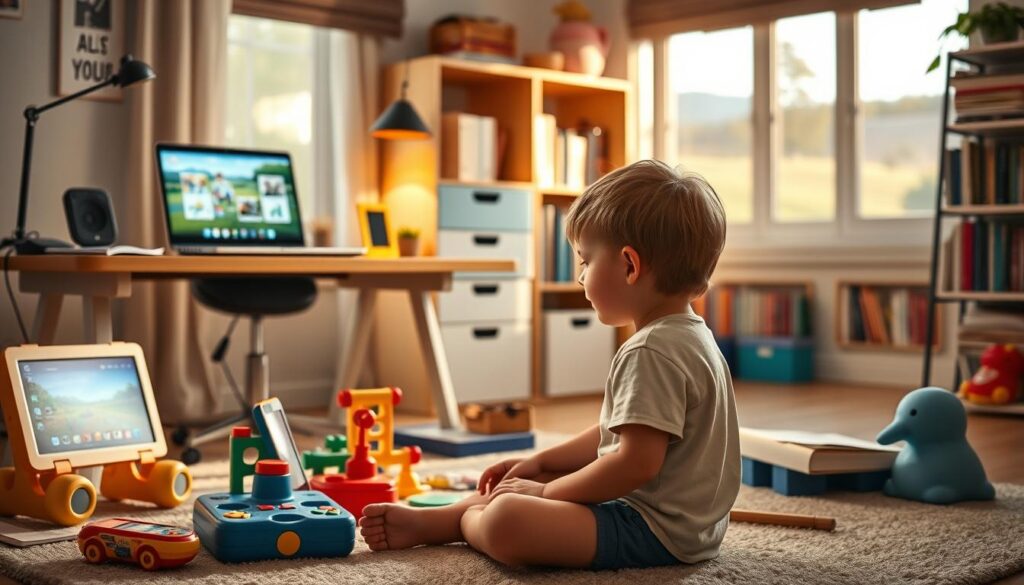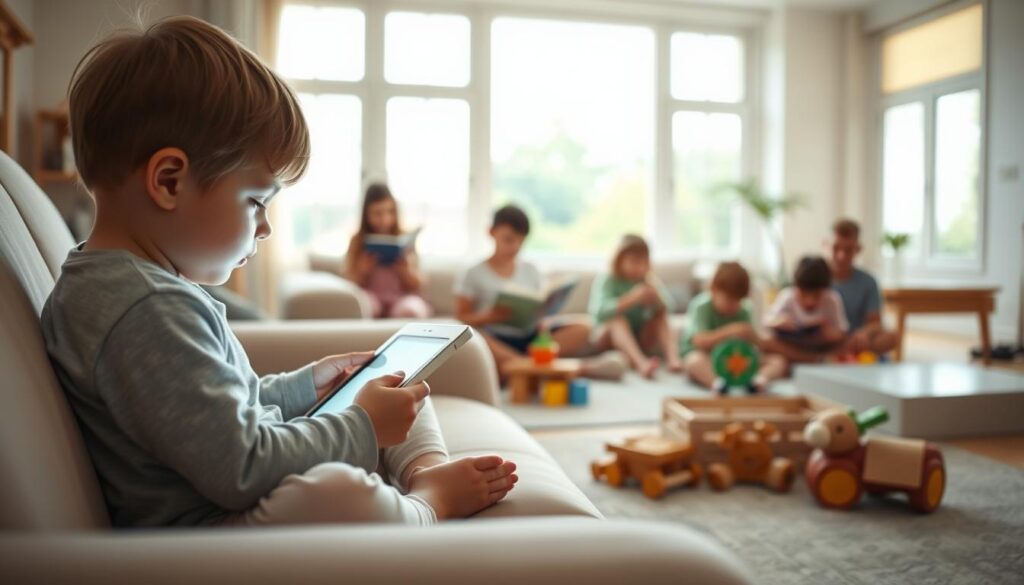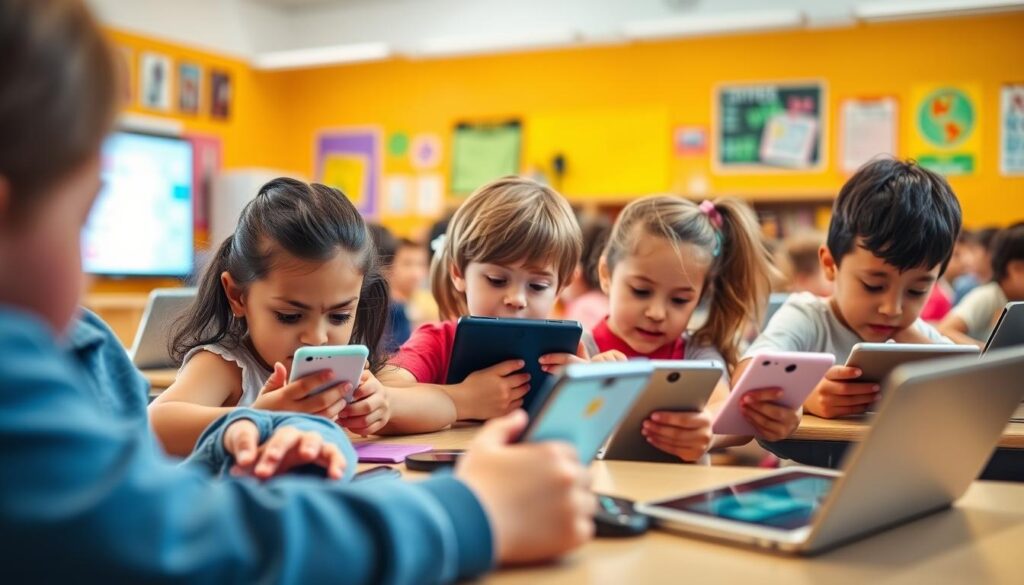Are we as parents being misled about the impact of screen time on our kids? As a parent navigating the digital age, I’m sure you’ve encountered the conflicting opinions and recommendations from experts. The American Academy of Pediatrics recommends no screen time for babies under 18 months, while the World Health Organization advises a one-hour limit from 2 to 5 years.
But what does research actually show about screen time for young children? In this article, we’ll explore the nuanced reality of how different types of screen time affect children differently, and I’ll share evidence-based insights to help you make informed decisions that align with your family values.
Understanding the Screen Time Debate
The conversation around screen time is ongoing, and as a parent, it’s natural to have questions about its implications. As we navigate this complex issue, it’s essential to consider the concerns that drive the debate and what the research actually tells us.
Why Parents Are Concerned About Screen Time
Parents are worried about the effects of screen time on their children’s development, from potential impacts on physical health to concerns about social and cognitive development. With the rapid changes in technology over the past two decades, it’s understandable that parents are seeking guidance on how to manage screen use.
What Research Actually Shows
Research has failed to justify the fears many parents have about screen time. Studies show that moderate screen use doesn’t have the devastating effects many fear. Instead, factors like genetics, socioeconomic circumstances, and parental involvement have much stronger impacts on child development. For more insights, you can visit Lunesia’s guide on screen time for.
| Factor | Impact on Child Development | Parental Role |
|---|---|---|
| Genetics | Strong influence on developmental outcomes | Understanding genetic predispositions |
| Socioeconomic Circumstances | Significant impact on access to resources and opportunities | Mitigating socioeconomic challenges through support |
| Parental Involvement | Crucial for cognitive, social, and emotional development | Engaging in activities with children, monitoring screen time |
Misconception #1: All Screen Time Is Harmful for Young Children
Not all screen time is created equal, and understanding this can help parents make better decisions for their children. The impact of screen time largely depends on the type of content and how it’s used.
The Difference Between Active and Passive Screen Time
Common Sense Media categorizes screen time into four types: passive, interactive, communication, and creation. Passive screen time involves watching videos or mindless scrolling, while interactive screen time includes playing games or doing puzzles. Understanding these categories can help parents evaluate the quality of their child’s screen time.
For instance, a child engaging in interactive screen time by playing educational games can be beneficial, whereas passive screen time watching random videos may not be as valuable.

Quality Matters More Than Quantity
The quality of screen time is more important than the quantity. High-quality, age-appropriate content can support learning and development, while poor-quality content offers little benefit.
| Screen Time Type | Examples | Potential Benefits |
|---|---|---|
| Passive | Watching educational videos | Learning new concepts |
| Interactive | Playing educational games | Developing problem-solving skills |
| Communication | Video calls with family | Staying connected with loved ones |
| Creation | Making digital art | Fostering creativity |
As a parent, it’s essential to ask questions about what your child is learning during their screen time. Research supports that brief exposure to high-quality content can be more beneficial than longer periods with low-quality entertainment media.
Misconception #2: Screen Time Guidelines Are One-Size-Fits-All
The assumption that a single screen time guideline can work for all children is not supported by research. As a parent, it’s essential to understand that every child is unique, and what works for one may not work for another.
Age-Appropriate Recommendations
While age is a significant factor in determining screen time limits, it’s not the only consideration. Research suggests that children of different ages have varying needs when it comes to screen time. For instance, younger children may require more limited screen time due to their developing cognitive and social skills.
A study on screen time guidelines for children highlights the importance of considering age alongside individual developmental needs. The table below summarizes some age-specific recommendations:
| Age Group | Recommended Screen Time |
|---|---|
| 2-5 years | 1 hour of high-quality educational content |
| 6-12 years | 2 hours of screen time, with breaks every 30-60 minutes |
Individual Differences in Children’s Responses to Screens
Beyond age considerations, children vary significantly in how they respond to and are affected by screen time. Some may become overstimulated or have difficulty transitioning away from screens, while others can self-regulate their use more effectively.
For example, children with certain neurodevelopmental differences may have stronger reactions to screen content or may benefit from specific types of educational technology tailored to their learning needs. As a parent, it’s crucial to observe your child’s behavior before, during, and after screen time to identify patterns and adjust limits accordingly.
By taking a more flexible and collaborative approach to managing screen time, parents can foster a healthy attitude towards technology in their children. Encourage your child to think critically about their screen time habits and help them set their own goals and boundaries.
Misconception #3: Screen Time Always Hinders Social Development
While some parents believe that screen time always hinders social development, the truth is more nuanced. Screen time can have both positive and negative effects on young children’s social skills, depending on how it’s used.

How Technology Can Support Social Connections
Technology can be a valuable tool for supporting social connections in young children. For example, video calls with family members or friends who live far away can help children maintain relationships and develop communication skills. Additionally, online platforms can provide opportunities for children to interact with others who share similar interests.
Balancing Online and In-Person Interactions
While technology can support social connections, it’s essential to strike a balance between online and in-person interactions. In-person social experiences provide irreplaceable opportunities for children to learn nonverbal communication skills, such as reading facial expressions and understanding body language. To achieve a healthy balance, parents can set regular screen-free times and spaces, like during meals or in bedrooms, to ensure that family connections and face-to-face interactions remain a priority.
| Activity | In-Person Benefits | Online Benefits |
|---|---|---|
| Social Interactions | Develops nonverbal communication skills | Maintains long-distance relationships |
| Play | Enhances physical activity and coordination | Provides access to educational games and content |
| Family Time | Fosters emotional bonding and shared experiences | Allows for shared online activities, like watching a movie together |
By being mindful of the role of screen time in their child’s life, parents can help create a balanced and healthy social environment that supports overall development.
The Real Impact of Screen Time on Young Children’s Development
Screen time is a ubiquitous part of modern childhood, but what does it mean for their development? As we navigate the complexities of raising children in a digital age, it’s essential to understand the real impact of screen time on their growth.
Physical Health Considerations
Excessive screen time can lead to a sedentary lifestyle, contributing to a range of physical health issues in young children. Reduced physical activity is associated with increased risk of obesity, decreased stamina, and other health concerns. It’s crucial for parents to balance screen time with outdoor play and physical activities to promote healthy development.
| Physical Activity Level | Recommended Daily Screen Time | Health Risks |
|---|---|---|
| Low | <1 hour | High risk of obesity, decreased stamina |
| Moderate | 1-2 hours | Moderate risk, potential for healthy habits |
| High | <1 hour | Low risk, healthy development |
Cognitive and Language Development
Research indicates that excessive screen time can negatively impact cognitive and language development in young children. A study by Tiia Tulviste found that higher screen time is associated with poorer vocabulary and grammatical skills in children aged 2.5 to 4 years. Interactive, educational content can support certain cognitive skills, but it cannot replace real-world exploration and human interaction.
For optimal language development, young children need abundant opportunities for conversation with attentive adults. Rather than relying on screens for learning, I encourage using technology as just one tool within a rich learning environment that prioritizes hands-on experiences and human interaction.
Effective Strategies for Managing Screen Time
Parents often struggle with managing their child’s screen time, but there are practical strategies that can help. As a parent, it’s essential to strike a balance between the benefits and drawbacks of screen time.
Beyond Time Limits: A More Balanced Approach
Creating a daily routine that includes a mix of screen-based and offline activities is crucial. Be sure to set aside time for physical activity, socializing, and family bonding. By doing so, you’ll help your child develop a healthy relationship with screen devices.
For more information on managing screen time, you can visit https://lunesia.app/screen-time-for-kids/ to explore additional resources and tips.
Creating a Healthy Digital Environment
Establishing a healthy digital environment goes beyond just managing your child’s screen time. It involves thoughtfully designing your family’s overall relationship with technology. You can achieve this by setting up tech-free zones and times in your home, such as keeping devices out of bedrooms and having screen-free meals.
Additionally, curate your child’s digital environment by pre-selecting quality apps, games, and content. Model healthy technology habits yourself, as children learn more from what we do than what we say. Create regular opportunities for enjoyable screen-free activities that help children discover non-digital interests and hobbies.
The Role of Parents in Modeling Healthy Screen Habits
Modeling healthy screen habits is one of the most significant roles you play as a parent in today’s digital age. Your children look to you for guidance on how to navigate the digital world, and your behavior sets the stage for their understanding of screen time.
As a parent, leading by example is crucial. This means being mindful of your own screen use and ensuring it aligns with the habits you wish to instill in your children. For instance, if you want your kids to limit their screen time during meals, you should do the same.
Leading by Example
Children often mimic their parents’ behavior, so it’s essential to model healthy screen habits. This includes being aware of your screen time, using screens purposefully, and engaging in screen-free activities. By doing so, you teach your children the value of balance in their digital lives.
Family Media Plans That Work
Creating a family media plan is an effective way to establish healthy screen habits for everyone in the household. Such a plan isn’t about imposing restrictions but about developing shared values and expectations around technology use. Here are some key elements to consider:
- Screen-free zones (e.g., bedrooms, dining areas)
- Screen-free times (e.g., meals, the hour before bedtime)
- Designated times when screens are freely available
- Promoting educational content, creative activities, and positive social interactions
A good family media plan addresses not just when screens are used but how they’re used. Regular family meetings to review and adjust your media plan help keep it relevant as children grow and technology evolves.
| Family Member | Screen-Free Zones | Screen-Free Times |
|---|---|---|
| Parents | Dining Area, Bedrooms | Meals, Hour Before Bedtime |
| Children | Dining Area, Bedrooms | Meals, Hour Before Bedtime |
By working together to create and follow a family media plan, you can foster healthier screen habits in your children and promote a balanced digital lifestyle for your entire family.
When Screen Time Becomes Problematic: Warning Signs
Identifying the warning signs of unhealthy screen time is vital for ensuring your child’s well-being. As a parent, it’s essential to be aware of the changes in your child’s behavior that could indicate a problem.
Behavioral Changes to Watch For
Keep an eye out for signs that your child’s screen time is becoming problematic. These can include changes in behavior, such as becoming increasingly irritable or withdrawn when not using devices. If your child is having trouble controlling their screen use or is consistently staying up late into the night to watch videos or play games, it may be a sign of a larger issue.
When to Seek Professional Guidance
If you’ve noticed concerning changes in your child’s behavior related to screen time, it may be time to seek professional help. According to experts, consider seeking help if your child shows signs of screen addiction, such as being unable to control their use despite negative consequences, or if their screen habits are significantly interfering with their sleep, academic performance, or physical health.
- If your child is accessing inappropriate content or engaging in risky online behaviors despite your interventions, professional guidance can help address underlying issues.
- For children with certain neurodevelopmental conditions, screen management may require specialized approaches that a professional can help develop.
As Kanojia suggests, understanding what fuels your child’s screen usage is crucial to overcoming it. By asking nonjudgmental questions and being aware of the warning signs, you can take the first step towards supporting your child’s healthy development in our complex digital world.
Conclusion: A Balanced Perspective on Screen Time for Young Children
The truth about screen time lies not in its inherent value or harm, but in how it’s used within the context of a child’s life. Like many aspects of parenting, it’s about finding a balance that works for your family.
As we’ve explored, screen time isn’t inherently good or bad; what matters most is how it fits into a balanced approach to childhood development. By focusing on quality content and ensuring that digital activities complement essential experiences, parents can help their children reap the benefits of technology.
Every family’s solution will be unique, based on their values and their children’s needs. By staying informed and trusting your instincts, you can create a healthy balance that supports your child’s development throughout life.
FAQ
How much screen exposure is considered safe for my kid?
The American Academy of Pediatrics suggests that kids aged 2 to 5 should limit their screen use to one hour of high-quality educational programming per day. For kids under 2, some screen time can be okay if it’s used to encourage learning and interaction.
Can screen time hinder my child’s ability to develop socially?
Not necessarily. While excessive screen time can be a problem, moderate use of digital tools can actually help kids connect with others and develop social skills, especially if they’re using video conferencing to stay in touch with family and friends.
What are some signs that my child’s screen time is becoming a problem?
If you notice changes in behavior, such as becoming more irritable or withdrawn, or if they’re having trouble sleeping or engaging in physical activities, it may be a sign that their screen time needs to be adjusted.
How can I ensure that my child’s screen time is having a positive impact on their development?
By choosing high-quality, educational content, setting limits, and encouraging physical activity and other hobbies, you can help your child get the most out of their screen time while minimizing potential risks.
What role should I play in modeling healthy screen habits for my child?
As a parent, you’re your child’s most important role model. By demonstrating healthy screen use habits yourself, such as putting away devices during meals or before bed, you can help your child develop similar habits.
Are there any benefits to using technology with my child?
Yes, technology can be a valuable tool for learning and development when used thoughtfully. For example, educational apps and games can help kids develop problem-solving skills and learn new concepts.




